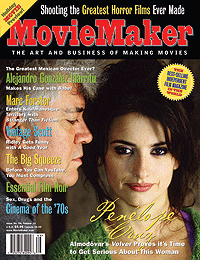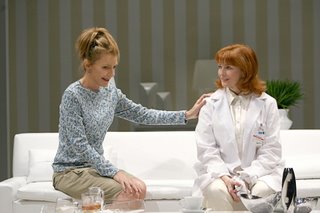
Notes on a Scandal (Fox Searchlight). Judi Dench rips it up and Cate Blanchett tears it down in a gratifyingly quick and nasty adaptation of Zoe Heller's page-turner. Directed with surprising verve by Richard Eyre, a theater veteran (Mary Poppins) more at ease with the medium here than with the plodding Iris (also starring Dench), it plays like What Ever Happened to Baby Jane? mixed with headline-grabbing material and British kitchen-sink realism, and fully capitalizes on an icily humorous screenplay by Patrick Marber. (The self-penned film version of his own play, Closer, leached out the bitter laughter of the superior source.) I thought Dench was lost forever to dear old ladyhood in last year's miserable Mrs. Henderson Presents, but she gathers herself together and strikes like a mamba as Barbara Covett (a terrific character name), a prim scold of a schoolteacher determined, in her fearsome, prideful loneliness, to make a cellmate of a new instructor, the willowy Sheba (Blanchett, shucking off the dullness of her roles in Babel and The Good German). Covett, who narrates the story from her tell-all diaries, sinks her fangs in when Sheba, a sweet but unformed personality with an older husband (Bill Nighy, as naturalistic as I've seen him) and retarded son, begins an affair with a 15-year-old student, with inexorably disastrous consequences all around. (The score, naturally, is by Philip Glass,the master composer of impending ruin.) Though the "L word" is never mentioned the film trafficks in female stereotypes; nonetheless, Dench is so assured she very nearly makes Covett the heroine she imagines herself to be. The sets and costumes, by Tim Hatley, are full of little symbolic touches that the DP, Chris Menges, makes sure you register without calling attention to them. And, at a time of year when most films top the two-hour mark, Notes is completed in a brisk 95 minutes. Not a nice movie, but kind of a fabulous one.

The Painted Veil (Warner Independent). Just as every Christmas brings at least one stuffed turkey, so, too, does it bring a film that I fear will be lost in the shuffle, and this year it is director John Curran's exquisite third version of W. Somerset Maugham's novel (the first, with Greta Garbo in 1935, is all about Garbo, as her creakiest vehicles tend to be). Critics and audiences who prefer films with lots of heavy-handed melodrama and emotional bombast need not apply to this more delicate and exquisitely modulated piece, which begins at a literal crossroads in the largely convenient marriage of Kitty and Walter Fane (Naomi Watts and Edward Norton). Kitty, who agreed to the union chiefly to escape her stifling family life, has had an affair with calculating British vice consul Charlie Townsend (played by her real-life boyfriend, Liev Schreiber) at their posting in 1920's Shanghai. Walter, a quiet, buttoned-down bacteriologist, realizes the adultery and has brought them from the city to the remote Chinese countryside, at a time of political unrest, to aid in a cholera outbreak--and quite possibly to die as a consequence (there is a streak of perversity underneath the period costuming and appealing natural landscapes, lovingly shot by Stuart Dryburgh). But Kitty, rather than wilt, slowly rises to the challenge of her circumstances and relationship. Entranced by the film, which casts a spell, Lora read the book and confirmed that there is no love story; Maugham didn't believe in romantic love, but more in spiritual transcendence, and I doubt he ever would have nudged the story into a more passionate dimension, as a recent New York Times article implied. Yet it works, thanks to fully realized portrayals by Watts (such a meaty role for an actress) and Norton, who effortlessly gives Ralph Fiennes a run for his money as Walter. (Under a nun's habit, Diana Rigg also shines, in one of those character parts whose payoff is withheld till almost the very end, and Hong Kong cult actor Anthony Wong has a sizable role, too.) Alexandre Desplat's Satie-derived score is just about the best I've heard since, well, the same composer's Baroque-influenced work for the otherwise marginal Casanova. A film to embrace.

Venus (Miramax). Midway through Roger Michell's elegiac drama there is an unsettling shot of a single, staring eye. The bluer-than-blue orb belongs to Peter O'Toole, and the entire film is a sustained death scene (I'm not really spoiling anything here) and requiem for the 74-year-old actor, who from the start looks as if he'll barely survive the opening credits, much less the closing ones. His stroke-like dissipation is startling and very nearly painful to watch, but he moves past self-exploitation to give a vinegary yet unsentimental performance as Maurice, a worn-down actor whose spirits are lifted by the uncouth 19-year-old grand-niece (Jodie Whittaker) of his ailing best friend (veteran character actor Leslie Phillips). Young Jessie is useless as a minder and health aide but has other rude charms, which Maurice gently, but firmly, seizes upon (their something-of-a-sex-scene is a surprise). Their May-December pairing is a companion piece to Michell and writer Hanif Kureishi's more deeply felt and disturbing The Mother, where 63-year-old Anne Reid romped with greater abandon with Daniel Craig, and is not its equal. But it does bring together, for the first time on screen and a handful of scenes, O'Toole and the undiminished Vanessa Redgrave, who, as Maurice's rueful ex-wife, has been given a cane to look impeded by age (to judge from her appearance, 69 is the new 49). And the star sparkles. It's as if O'Toole is saying, "I may live a few more years, and play a few more parts, but this is it--the most and best I can give you."
And to all a good night, as I, still needing to catch up with a few new releases to create a definitive Top 10 list for my 100th post, take a bit of a hiatus.




























